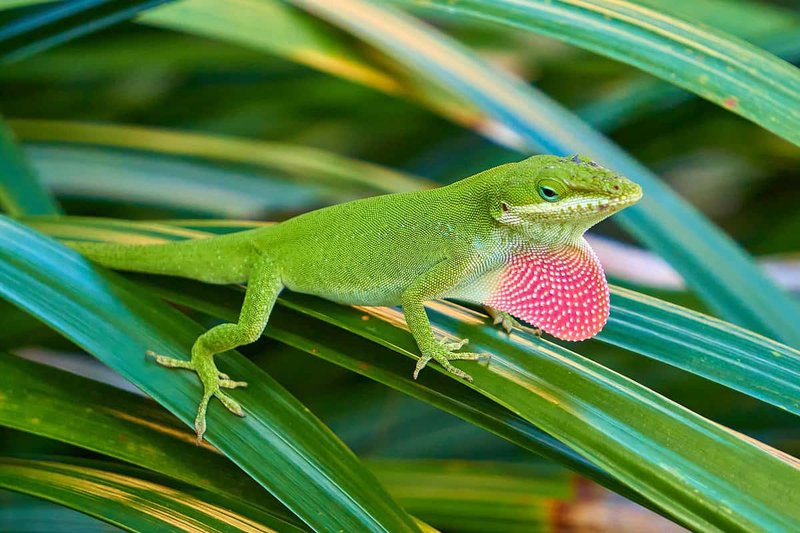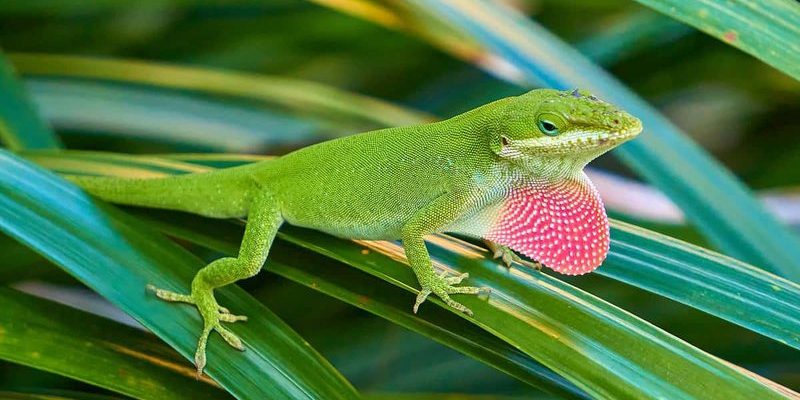
To answer that, let’s dive into what anoles really are, their behavior, and how they interact with people. Think of it like getting to know a new neighbor: at first, you might be a bit cautious, but once you understand them, you can decide how to engage—or if you even need to worry at all.
What Is an Anole Lizard?
Anoles are small lizards that belong to the family Polychrotidae. You’ll often spot them in places like southern United States, the Caribbean, and parts of Central America. There are several different species, but one of the most well-known is the Green Anole. They’re famous for their vibrant green color, though some can turn brown depending on their environment or mood.
These lizards are generally small, ranging from about 4 to 8 inches long. They have slender bodies, long tails, and distinctive throat pouches called dewlaps, which they use for communication and mating displays. Imagine a tiny, colorful dragon puffing up its throat to look more impressive—it’s quite the sight!
Do Anole Lizards Have Any Venom?
If you’re worried about safety, here’s the good news: anole lizards are completely non-venomous. This means they can’t inject venom like some snakes or spiders. Their primary defense mechanism is actually their speed. When threatened, anoles can dart away quickly, sometimes even dropping their tails to escape. That’s pretty impressive, right?
While they may look fierce when they puff out those colorful dewlaps, their intentions are far from dangerous. Anoles primarily feed on insects, which makes them great little helpers in keeping pest populations down. So, while they might seem a bit intimidating at first glance, they’re actually quite harmless.
Are Anoles Aggressive?
You might be wondering if the anole lizard is aggressive. The simple answer is that they usually aren’t. Anoles prefer to avoid confrontation and only resort to puffing up or displaying their dewlaps when they feel threatened or challenged by other males.
In fact, these lizards are more interested in their territory than in bothering humans. If you see one in your yard, it’s likely just going about its business catching flies or basking in the sun. However, if you corner one, it might try to escape, so it’s always best to give them space. They’re more beneficial to have around than you’d initially think!
Do Anoles Carry Diseases?
Another common concern people have is whether anoles can transmit diseases to humans. While many animals can carry diseases, anole lizards are not known to be common carriers of zoonotic diseases (diseases that can be transmitted from animals to humans). They are largely considered safe pets, especially when compared to other reptiles, like snakes, which can sometimes carry salmonella.
That said, it’s a good practice to wash your hands after handling any lizard—or any animal, for that matter. This helps prevent any potential transfer of bacteria, even if it’s not specific to anoles. So, while they’re not dangerous themselves, a little hygiene goes a long way!
What Should You Do If You Encounter an Anole?
If you happen upon an anole lizard in your yard, there’s no need to panic! Here’s what you can do:
- Observe: Take a moment to watch it from a distance. They’re fascinating creatures that can teach you a lot about local wildlife.
- Do not catch: Unless you’re experienced with reptiles, it’s best not to try to catch or handle them. They’re shy and may stress if grabbed.
- Encourage biodiversity: A healthy garden often has various insects—and the anoles help manage those pests. So, instead of chasing them away, let them do their job!
By respecting their space, you can safely coexist with these little lizards.
How to Care for Anoles as Pets
If you’re considering bringing an anole into your home as a pet, you should know how to care for them properly. Here’s a quick rundown:
- Terrarium setup: Anoles need a well-ventilated terrarium with plenty of climbing structures, like branches and plants. They love to climb!
- Temperature & humidity: Keep the environment warm but not too hot. A basking area around 80-85°F and a cooler area of around 70°F is ideal. Humidity should be around 50-70%.
- Diet: They thrive on a diet of live insects, like crickets and mealworms. Dust their food with vitamins to keep your anole healthy.
Taking care of an anole can be a rewarding experience. They’re unique little companions that can thrive in a well-maintained environment.
Wrapping Up: Should You Worry About Anoles?
In summary, the anole lizard is not dangerous to humans. They’re non-venomous, typically not aggressive, and don’t carry diseases that can affect us. So, the next time you see one in your backyard, take a moment to appreciate these little lizards. They’re doing their part to help control pests and add a splash of color to your garden!
Remember, understanding these creatures can lead to a healthier coexistence. Just always give them space, enjoy their quirks, and know that they’re not out to get you!

